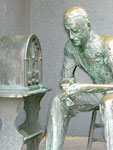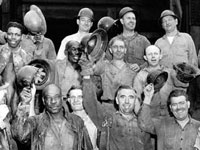This website features 9th-grade students in Maryland taking the role of critics to analyze President Franklin D. Roosevelt's Fireside Chat on the Works Relief Program (April 28, 1935). This lesson guides students to shape a more nuanced understanding of the Depression and the New Deal, and thus engages them in questioning the evitability of programs often treated by history as inevitable or obvious.
Students study Roosevelt's Fireside Chat and consider what it would have been like to be an everyday American listening to it. They then switch roles to take the place of one of five critics of Roosevelt's New Deal policies to dig more deeply into the sources.
This video provides examples of two promising practices:
- Using multiple perspectives to critically analyze a complex primary source document;
- Questioning the tendency to think of history as a progression of inevitable events.
The Lesson in Action
The Classroom Practice and Teacher Analysis section presents video of classroom instruction interspersed with the teacher's reflections on the lesson. During the warm-up, students imagine what might have been on their minds had they lived in 1935. Keeping these concerns in mind, they listen to the April 28 speech and reflect on what it says and how it could have helped gain support for New Deal programs.
The use of multiple historical perspectives challenges students to engage with the source—FDR's speech—and to think carefully about the complexity of historical moments.
Students then work in groups as critics of the New Deal. Playing the role of a prominent critic (Huey Long, Jouett Shouse, Upton Sinclair, Norman Thomas, or Rev. Charles Coughlin), they craft a rebuttal to FDR's policies. The use of multiple historical perspectives challenges students to engage with the source—FDR's speech—and to think carefully about the complexity of historical moments. Each group presents its critique of the New Deal and the class votes on the most compelling criticism.
This lesson is effective in having students critically engage with the primary source. As critics, they are challenged to read Roosevelt's speech carefully to discern what he says and how he says it, and to unpack the nuances of his argument. Turning over the process of learning to students actively engages them in thinking of history as dynamic, complex, and subject to interpretation.
This activity makes use of a variety of historical perspectives to help students better understand the New Deal, its supporters, and its critics. You can find a comprehensive lesson plan, complete with additional primary sources, background information, and classroom worksheets, on the website.


